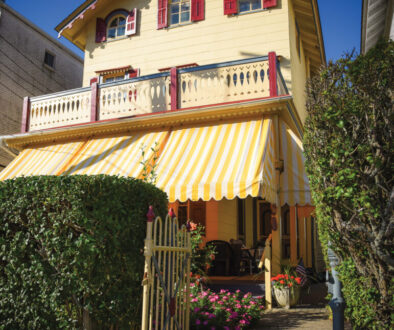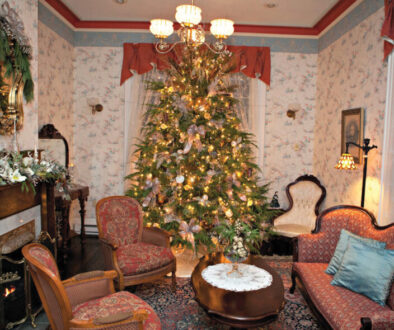Hidden Treasures
The bonuses found in home renovations

For people who love and live in old and historic homes, the renovation and the finished living spaces are often their own reward. After all, from reparations and updates to walls, floors, electrical and plumbing systems—not to mention the work that goes into the siding and roofing—a historic home renovation is a labor of love.
The reward, of course, can be immense. The goal of many historic renovations is to endure the exhausting and stressful restoration process and emerge unscathed, with a beautiful home that is as much an homage to the past as it is practical for the present—and future.
For some, however, a home restoration results in more than the intended goal; it results in the discovery of hidden treasures.
We’re not talking about the types of hidden treasures in The Goonies—we haven’t spoken to anyone who encountered piles of jewels or buckets of gold in or near their homes. Rather, we’re talking about the types of treasures that are historical in nature, offering a glimpse of the past lives of local homes and the people who once lived inside them.
When Tracie and Steven Ferra bought their West Cape May home in 2018, they didn’t have any expectations beyond finally owning a home in West Cape May. “We bought the worst house,” laughs Tracie as she describes the purchase of her home. “Every other house we tried to buy was sold.” Now nicknamed “The Hidden Gem” with its own Instagram page, the Ferra’s house was in terrible condition when they bought it.
“You could see through the walls, past the cedar shingles, and every door was missing,” says Tracie.
The Ferras knew they had an enormous amount of work on their hands, work that would take over a year of meticulous care, the restoration and raising of the entire house, and a commitment to bringing back as much history as they could by using antique rim locks and knobs, milled wood from Schairer Brothers Sawmill in Egg Harbor City, and as much reclaimed material as possible. “We’ve tried to find things [for the house] that would exist a hundred years ago,” says Tracie.



What they didn’t know was that the bones of their house had stories of its own.
“We were pulling down plaster and lath, in Tyvek suits and goggles, working on the ceiling between the second floor and the attic, and a box of documents fell out,” says Tracie. The documents within the box were fairly blackened with age. Tracie cleaned them with a special tool that blots and takes out the dust, and then photographed them. They are a treasure trove of papers documenting life at the turn of the century.
Among the documents was a receipt for a new gas range from 1904; a Riverboat excursion ticket from 1909; a collection of bank notes; papers from an 8th-grade student named Barbara Murphy from 1900; tiny little envelopes for church donations to the Calvary Orthodox Presbyterian Church in Wildwood; ice and coal receipts; harness repair receipts from William McFadden Harness and Horse Supplies; a ledger page with the names and addresses of Cape May neighbors; a small four-page magazine of women’s clothing; an invitation from the Clerks Office at the House of Representatives; and so much more.
While other items have been found on the property—among them an Indian Head Penny, stamped paving bricks, and an iron bed frame—it’s the documents that have given the Ferras the most comprehensive glimpse into the history of their house. Fascinated by what they had uncovered, Tracie took to the National Archives in Washington, D.C. to learn more about her home.
Ferra was able to trace ownership of the house back to 1879. According to her research, Ferra explained that the house was at one point part of the Eldredge estate, before changing hands to the Homan Family, whose documents Tracie has been inadvertently entrusted. “I have a discharge document from 1893 showing the owner, Walter Homan, used to work at the Lighthouse,” says Ferra.
In addition to the items found in and around the house, there’s history to glean simply from the surrounding property. “The house was coal heated,” says Tracie. “And every time it rains, coal comes up in the yard.”
While Tracie has always had an appreciation for history and historic places, finding these items in her own house has prompted her to act as de facto historian of her property, storing items in acid-free boxes and tracking what she finds on her house’s Instagram account.


“We had no idea the house had this in it.”
Tom Raniszewski, a prior owner of the former Prince Andrew (across from The Southern Mansion and now a private home), had his own renovations to undertake.
“It’s a lot of work when you live in a historic home. People would ask me if I was handy,” says Tom. “And I’d say, ‘I am now’.”
While Tom owned the home, he had the good fortune to meet a previous occupant of his house. “In the 1920s, Jack Sayre was a little boy growing up there,” says Tom. “He’s in his 90s now, and he came to the house when I lived there with my son Andrew.”
Tom asked Jack to give them a tour of the home as it would have been when he was growing up there, and while doing so, Jack explained that during the summer months, all of the kids’ living quarters would be on the third floor so that their parents could rent out the lower floors. During those summers, Jack and his brother made model airplanes, and would have them hanging all over the space.
“Three or four years later, I was working on the floor in the third level,” says Tom. “I had to remove a floor plank…and I found a metal propeller from a model airplane. I would never have known what it was if Jack hadn’t told me his story.”
Better than simply finding the propeller, Tom was able to share his discovery with Jack. “That Sunday, I went to the Methodist Church and handed him the propeller,” says Tom. “It was almost like he was gazing into the past.”






Another find for Tom was on the creepy side. “When I first got into the house, we were doing work underneath it and found all these bones,” says Tom.
Luckily, the bones weren’t of the sinister variety, and in fact, helped shed more light on the details of a life in Cape May in the last century. “Jack told me the story of a dog they had,” says Tom. “There was a butcher shop at the time, around Lafayette and Ocean, and the dog would walk to the butcher shop and get a bone. When he was done with it, he would bury the bones under the house.”
Tom’s third find also involved Jack Sayre. “In the back, I was digging a little fishpond and found a little piece of metal with the initials J.S.,” says Tom. Again, he brought his find to Sayre, who said, “I made that for my bicycle.” It was the equivalent of a personalized license plate for his bike.
Tom owned the house for 11 years, and even then, the newest part of the home was over 100 years old. While it was a lot of work to renovate and keep up, Tom and his son loved the house. As such, they wanted to leave their mark, just as Jack Sayre had unintentionally done before them.
“I don’t know if I should reveal this,” says Tom, “but we made sure that someone would find some evidence of us.” While he wouldn’t say what it is, or where it is located, there’s likely a personal find that a current or future resident of the home will make someday. When they do, they can know it was from Tom.
Dick and Deni Regensburg purchased their historic Upper Township home 36 years ago in 1983. When they did, it was in such a state of disrepair that during a nor’easter that year, the water poured in all over the shag carpet.


The house, identified as the John Corson Jr. House and now in the National Register of Historic Places, was built circa 1710. “The place was in dreadful condition, it should have been a teardown,” says Dick. “The good part was that the frame was done properly. “
Dick, who is a retired archaeologist and has worked in hundreds of historic houses, was just the person to restore this particular home. While the house stayed in the Corson family until 1956, it was then sold to a local builder who used it as a storage garage and the surrounding grounds as a trash pit. It was then sold and used as a rental property before the Regensburgs arrived to save it.
In addition to having researched every single deed and the history of John Corson Jr.—including the subterranean dwelling occupied by Corson’s father and uncle, John and Peter Corson, after their arrival here in 1685—Dick was able to identify and catalog every item he found on the premises.
“Probably the neatest thing I found in the home was when I was taking the multi-layers of walling out of the second floor,” says Dick. “They had red cedar on rotted sheet rock on rotted fiberglass. When taking it up, I discovered a hand blown medicine bottle from 1760, as well as a wooden tool that was used to line up holes when pegging a wall together.”
Another fun find was the discovery of women’s shoes from the 1800’s located under the kitchen lean-to. “They aren’t in pairs, they are single shoes from a pair,” says Dick. “It was likely some sort of historic ritual.”
As for the hundreds of ceramics pieces Dick found located on the property, each of which has been documented and catalogued, he can offer some archaeological insight.

“Early on, in the 1700s, you had limited stuff. If something broke, you swept it out the door and under the lean-to. As you got more stuff, you’d start burying it,” says Dick. “These are the earliest ceramics, with the blue scratching…European stuff brought in during the 1700s.”
In addition to the ceramic pieces, Dick has collected a variety of coins, the oldest of which is from 1787 and another, which was found around the base of the chimney, from 1834; little violin bottles; metal objects like thimbles and fragments of women’s belt buckles; a pewter spoon, which tells us about the social status of the people who lived there (they were not the silver or gold people, but used pewter, which was the next level); a very small porcelain doll found next to the dog house outside; dozens of nails from different decades, identified by the shape of their head, some from 1825, and older ones that incorporated the use of charcoal; an 1825 spike that was used to put the roof back up after it was elevated to make a two story home and which was found next to the aforementioned medicine bottle; and an assortment of arrowheads.
While cataloging these items is almost second nature for Dick, given his archaeological background, he does have some resources to use as a reference, including a well-worn copy of All the Best Rubbish by Ivor Noel Hume, who, according to Dick, is “one of the best historical archaeologists who ever lived.”
Now restored with an enormous amount of historical accuracy, the house has only a few nods to modern day. While it is home to Dick and Deni, it’s also a true historical space, complete with furniture and décor that lends itself to an authentic old home.
“Not everyone could live like this,” says Deni. “But we love it.”



